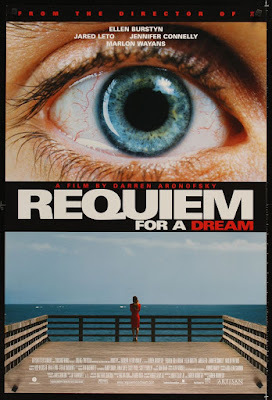 |
| Fig 1 - Requiem for a Dream Poster |
Requiem for a Dream, directed by Darren Aronofsky, tells the story of four individuals' descent into addiction in various attempts to pursue their goals. Aronofsky himself refers to it as an "urban horror film," that "isn't scary in the traditional sense," but "in the way that people's dreams turn into nightmares." (Aronofsky, 2000). The film begins with a dual-perspective scene in which Harry Goldfarb (Jared Leto) is once again taking his mother's television to sell for drug money. His mother, Sara (Ellen Burstyn) sits terrified behind a locked door on the left of the screen, whilst Harry fails to coax her out on the right side. Inevitably, Harry gets the money he needs and shares it's rewards (which in this case are heroin) with his equally addicted friend Tyrone (Marlon Wayans) and his girlfriend Marion (Jennifer Connelly). It is clear that these twenty-somethings are constantly living off the high of their last fix and make no bones about delving into the dark underworld in which the drug trade is suddenly dwindling. Harry and Tyrone plan to 'buy in bulk' and make a profit off selling to users on the street which, for Harry, would allow him and his girlfriend to open their own store. Alongside this, we follow the story of widowed pensioner Sara Goldfarb, whose remaining pleasures in life consistent of unhealthy treats and vehement television-watching. When Sara receives a phone-call telling her she's been chosen to appear on television, she can hardly believe it. Although, Sara soon realises she'll have to slim down in order to fit into her favourite red dress and, having failed at dieting, is irresponsibly prescribed weight-loss pills to help things along. It soon becomes clear that her regimented amphetamine intake has become an addictive habit and eventually leads Sara down a chaotic path which parallels the downfall of her son and his familiars...
Ellen Burstyn was nominated for Best Actress at the 73rd Academy Awards for her portrayal of Sara Goldfarb, a character who required extensive makeup and prosthetic application to achieve the look of Sara's various 'stages'. Having now seen the film a third time, I can safely say that Ellen Burstyn's performance is the most tragically watchable element throughout. Having said that, I think that equal credit is deserved by Jennifer Connelly who gives an incredibly raw performance that proves to be tragic in a much different way.
 |
| Fig 2 - Requiem for a Dream - Harry and Marion |
As a whole, the film does not go easy on the senses and proves to be a difficult watch even if you know what's coming. The last twenty minutes are particularly harrowing as the culmination of four intense situations reach their apex, making
Requiem's climax one of the most distressing ends to a film that I can recount. It is, in this sense, more of a 'Reagan-era PSA' than
Trainspotting (1996), which deals with the subject of heroin addiction in a comparably light-hearted way. But I do think
Requiem is the better
film of the two, despite liking
Trainspotting more. The editing feels somewhat reminiscent of
Natural Born Killers (1994), in which the deliberately fast-paced cutting gives the audience a window through which to channel the characters' experiences. With rapid-fire shots of lighters flicking to life and iris' widening as characters indulge in their escapism; when they take drugs, we're taking them too.
Incidentally, much of the film's relentlessly bleak atmosphere comes from it's score by composer Clint Mansell. Though popular culture has used it's main theme "Lux Aeterna" in countless attempts to 'amp up' certain singing contests, the orchestral piece remains a haunting backdrop to the hopelessness of the film's narrative and plays out almost as an audible warning of things to come. However, for my money the most effective piece (entitled "Meltdown" on the soundtrack) plays out in it's entirety during the final act and perfectly coincides with the horrific imagery on-screen. Something about the foreboding echoes of the strings and harsh vibrato give an already difficult scene more of a stomach-churning edge, making the experience of watching all the more memorable.
Requiem for a Dream is a film that will stay with you long after it's over, whether you want it to or not. It succeeds greatly in communicating the mindset of it's characters and boasts stimulating visuals that mimic the growing dread of their desperation. Certainly not for the faint of heart, though. You may want to follow this up with
Fear and Loathing in Las Vegas (1998) to readjust your stance.
★★★★★
Imagery
Fig. 1 Requiem for a Dream Poster (2000) From: Requiem for a Dream - Directed by: Darren Aronofsky
https://www.mauvais-genres.com/4059/requiem-for-a-dream-1sh-movie-poster-00-drug-addicts-jared-leto-jennifer-connelly.jpg
Fig. 2 Requiem for a Dream Screenshot (2000) From: Requiem for a Dream - Directed by: Darren Aronofsky
http://theredlist.com/media/database/films/cinema/2000/requiem-for-a-dream/001-requiem-for-a-dream-theredlist.jpg
(Aronofsky, 2000)
Mini Documentary - The Making of "Requiem for a Dream"
https://www.youtube.com/watch?v=DxockfJddFU&ab_channel=EdgarBumpers



No comments:
Post a Comment